A display deathmatch - should you buy a gaming TV or gaming monitor?
A screen showdown for the ages - here's what to consider when preparing to buy a gaming display
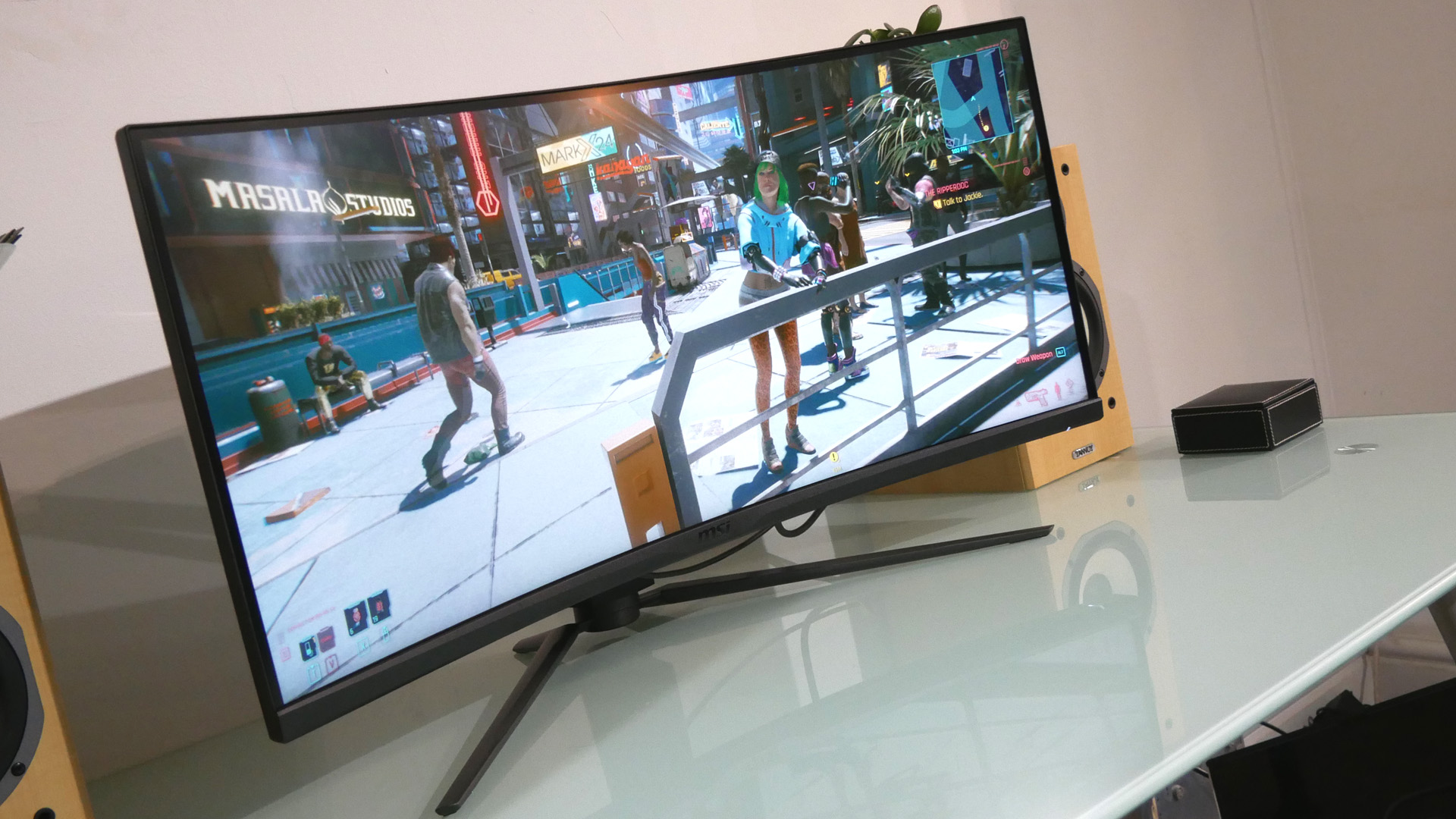
Love gaming? You absolutely need a good display. But do you want, or need, the best gaming monitor or the best gaming TV? Now that’s a tough question. In days of old, deep in the mists of the ‘90s and ‘00s, the answer was simple: if you're playing on the best gaming PC, you get a monitor. For console? That’ll be a TV.
But it's no longer so clear-cut. Some of the latest TVs have gaming-centric features that make them a great fit for a certain kind of PC gaming. And the Xbox Series X and PS5 also both work better with at least some gaming monitors than any previous generation of gaming boxes - and there are new heights in gaming TVs, generally, as the best TVs for PS5 and Xbox Series X show.
Long story short: both TVs and monitors can now be a great fit for either PC or console gaming. The catch? That needs qualifying, as it doesn’t apply universally. But that’s exactly what we’re here to investigate. When and why, exactly, should you choose a monitor or a TV for gaming?
Going big with a gaming TV
Best for: Most types of console and big-screen PC gaming; but not serious esports on the PC.
Pros:
- Superior HDR performance
- OLED tech is super speedy
- 120Hz refresh and adaptive sync are now available
Cons:
- Quite expensive in the ideal spec
- Subpixel payout can be problematic on PC
- Sheer size is not always ideal for PC use
Big, dumb, and almost certainly slow - so it used to go for early flat-panel TVs. Sure, you got a much larger screen than most monitors, but the resolution was low, the pixel response was poor, and the input lag? In a word, chronic.
For a certain kind of mainstream console gaming, that was fine - all you wanted was a big, bold screen for bouncing around in your Mario Kart. And, anyway, your console didn’t support PC-style high resolutions. But now consoles like the Xbox Series X and Sony PlayStation 5 are much more demanding in terms of resolution, refresh rates, and the rest, while console gaming has expanded to include genres that live and die on latency, like competitive online shooters.
Happily, recent TV technology has kept those original characteristics. For starters, 4K or 3840 x 2160 pixel native resolution is pretty much the norm, even on budget sets. Just as important, the big brands like LG and Samsung now pay attention to issues like input lag, which used to be so debilitating to responsive gaming on old TVs.
What’s more, OLED technology is now widely available in the TV market and the best OLED TVs are more affordable than ever. That matters because OLED panels have inherently superior pixel response to any LCD monitor. Grey-to-grey pixel response, the most commonly quoted measure, is sub-1ms for an OLED. Full on-off response is in the region of 1-2ms. Full on-off response for a modern gaming LCD panel? Anywhere from 5ms to 15ms. OLED is far faster.
Sign up to the GamesRadar+ Newsletter
Weekly digests, tales from the communities you love, and more
Rounding out the most significant gaming-relevant advances, you can now get TVs with true 120Hz refresh support, including at 4K, adaptive refresh, and the all-important HDMI 2.1 interface. These form the best 4K 120Hz TVs currently going and the HDMI 2.1 is essential for hitting high resolutions and refresh rates, at the same time, a capability that defines the latest generation of consoles.
The go-to example here is LG’s C Series OLED, including the LG CX from 2020 and this year’s updated LG OLED C1 and LG OLED G1. You get 4K resolution, 120Hz refresh, HDMI 2.1, adaptive refresh, and low latency, plus all the usual benefits of OLED tech including essentially infinite contrast and that uber-fast pixel response.
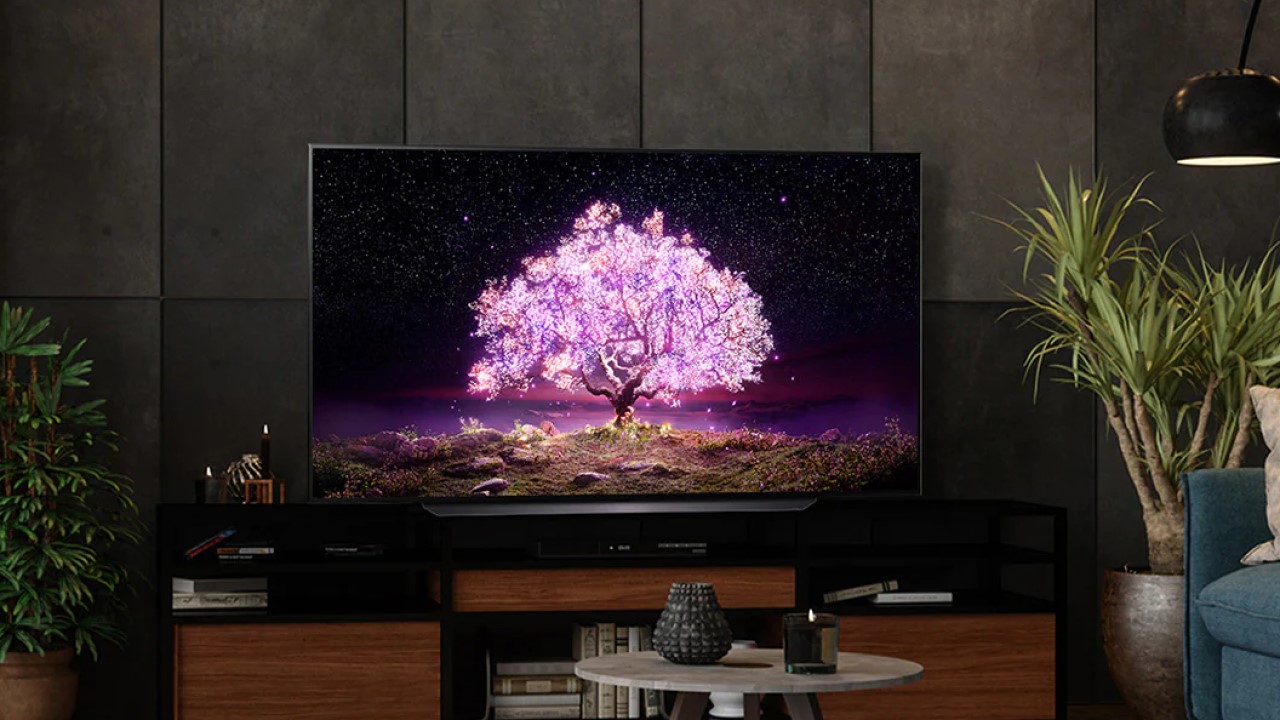
Fire up a graphics masterpiece like Cyberpunk 2077 on a high-end gaming PC, and it will look utterly stunning on an LG C Series. The same goes for console gaming: Dirt 5 or Forza Horizon 4 on, say, a 55-inch C Series will blow your mind. Frankly, everything looks great, strategy titles on PC like the Total War franchise, epic RPG adventures like Assassin's Creed Valhalla, the lot.
One caveat is when it comes to pricing: you can get 48 and 55-inch versions of the CX for around $1,300 / £1,100 (at time of writing). Not exactly budget pricing, but as a long-term investment, arguably pretty reasonable - particularly given that it'll likely be used in other ways too for home entertainment.
But, there are limitations, of course. TVs top out at 120Hz for true refresh rates, so don’t be fooled by sets claiming 240Hz or similar (this typically involves frame insertion technology and not actually updating the image at 240Hz). Meanwhile, gaming monitors running up to 360Hz can now be readily bought. For esports, the higher the refresh, the better. However, that’s arguably most relevant for PC. After all, even the latest consoles top out at 120Hz, so you’ll get no benefit in that regard from teaming one of them with a faster monitor.
It’s also worth noting that if you want the very best in HDR performance from a TV, you have a tricky choice. OLED panels have far superior black levels and contrast, but the best QLED TVs like the Samsung QN95A offer much better brightness and as a consequence also offer better detail in brighter HDR scenes. Currently, there is no one panel tech that’s better for HDR across the board. For that, we’ll have to wait for micro-LED panels to become affordable.
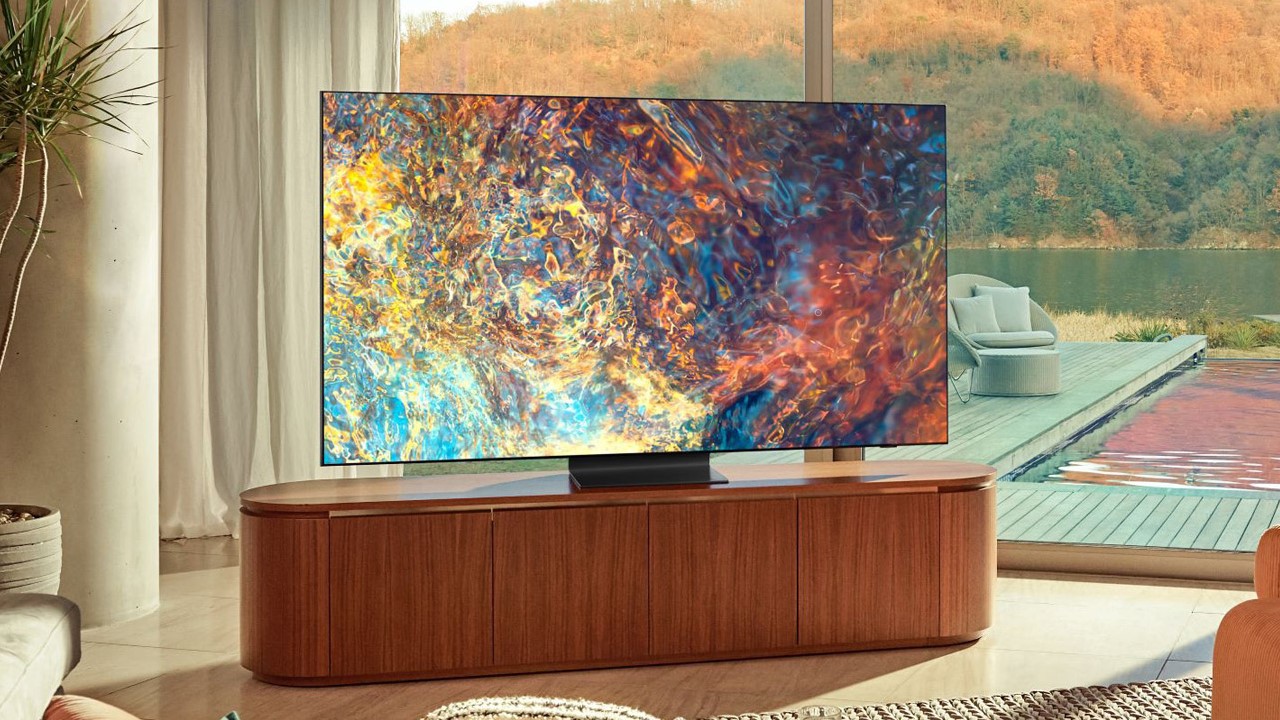
The final issue regarding a TV as a PC gaming monitor is sheer size: 50-inch plus sounds great, but it’s not hugely ergonomic as a desktop monitor. Similarly, the bigger the set, the bigger the pixels. Sure, you could go 8K and quadruple your pixel density. But good luck finding a GPU even among the very best graphics cards that will be able to play the latest games smoothly at 8K.
Anyway, a suitably specified TV makes for a fabulous console gaming panel and an excellent screen for big-screen PC gaming. Just don’t assume it’s going to be ideal as an all-around PC monitor, some issues remain.
Gaming monitors - no longer the realm of the PC-only players
Best for: Esports and performance-sensitive gaming, plus all-round PC usage and wherever space is at a premium.
Pros:
- Available with super-high refresh rates and low latency
- Better fit for desktop gaming
- Superior peak brightness to OLED TVs
Cons:
- LCD tech still problematic for pixel response
- Expensive for the size of screen you get
- Few monitors offer true HDR performance
There's a terrifying array of options and choices when it comes to the best monitors for gaming nowadays. Big, small, ultrawide, uber curved, crazy refresh rates, funky backlight technologies, confusing performance claims. How do you make sense of it all? There are so many sub-categories of monitors for gaming now, it can be hard to navigate to the best one for you.
One thing to be aware of is that ultrawide aspect ratios are currently problematic for even consoles, and yes that includes the very latest Xbox Series X and PS5. Future updates are expected to begin to bring wider support for various resolutions and aspect ratios. But for now, 1080p and 4K monitors for gaming are guaranteed to work with the PS5, while the Xbox adds 16:9-aspect 1440p support. That’s a pity when there are fabulous ultrawide monitors like the MSI MPG Artymis 343CQR and the Samsung Odyssey G9 to choose from.
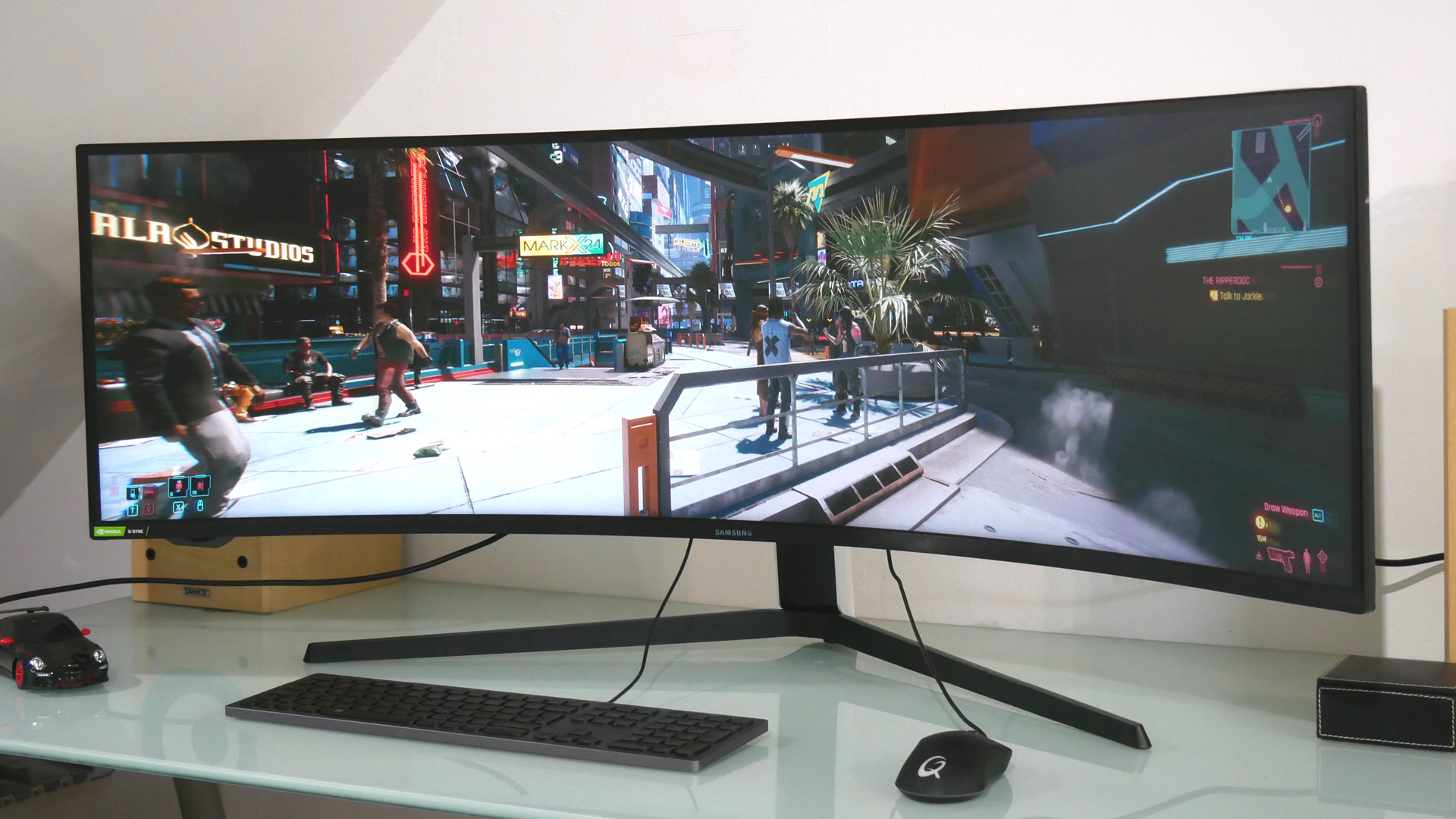
With that proviso dealt with, the first thing to understand about gaming monitors is that they’re pretty much all LCD-based. The term ‘LED monitor’ typically refers to an LCD monitor with an LED backlight. But not all LED backlights are equal. Non-HDR (otherwise known as SDR or standard dynamic range) monitors have monolithic backlights, while some HDR monitors have local dimming, allowing granular brightness control across the panel. The problem is that many local dimming implementations are so crude - perhaps as few as eight to 16 dimming zones - as to be pointless. Even the latest mini-LED backlights on megabucks monitors like the ASUS ROG Swift PG32UQX only have a thousand or so zones. A 4K OLED TV effectively has eight million zones - each pixel is a fully controllable light source. Put simply, there are few monitors currently available that can render a true HDR image. LED backlights are great at showing really bright scenes, but poor at mixing bright and dark elements in a single image - which is ultimately what HDR is all about.
Pixel response is another tricky area. Two monitors both rated at 1ms can have quite different pixel response due to the unreliable methods used to measure performance. A good example is the ASUS ROG Strix XG43UQ. It’s rated at 1ms but has poor response in the real world. Do your due diligence on any panel you are considering; for instance, look for reviews on GamesRadar and our sister websites.
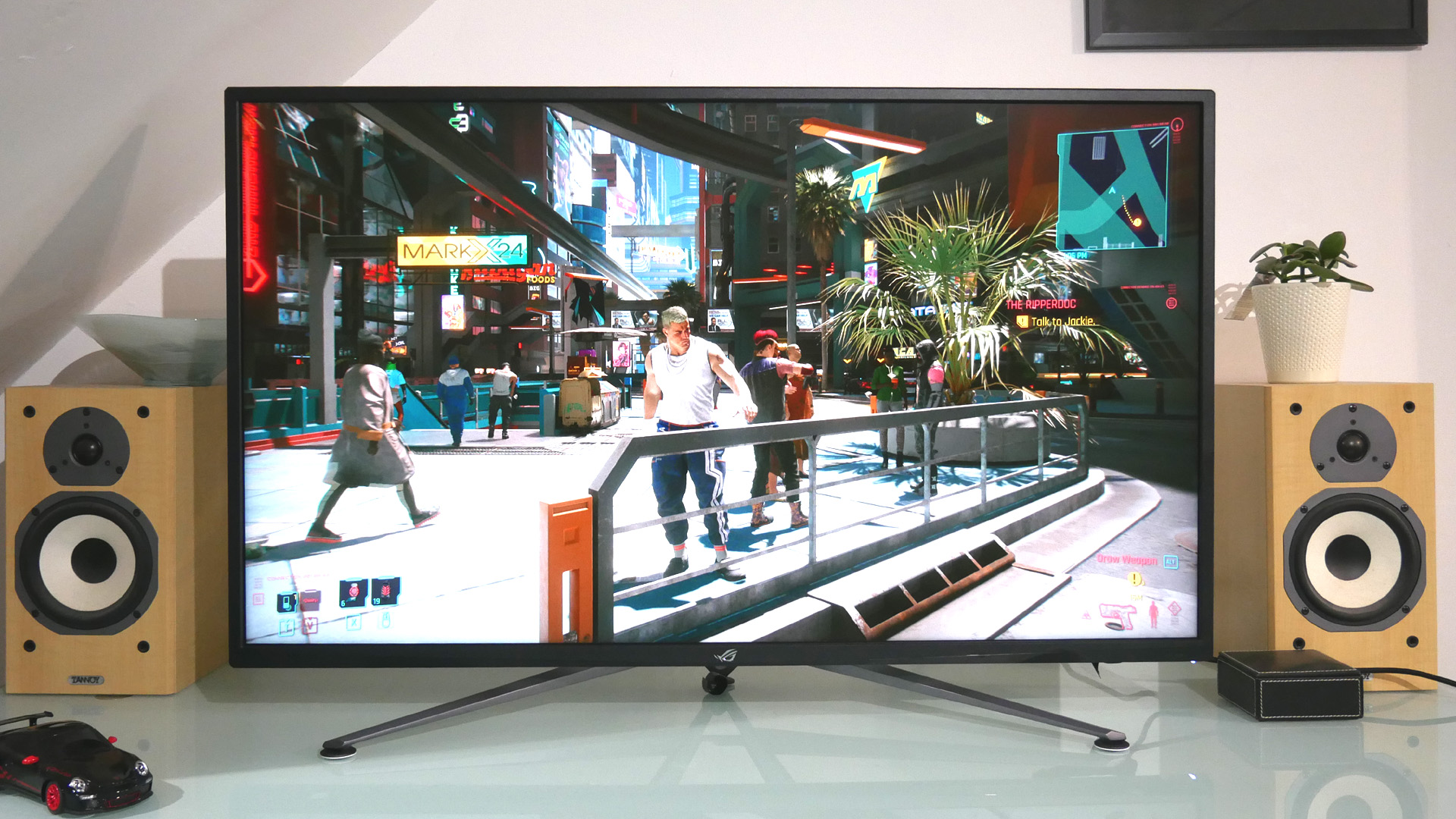
Another issue to be aware of is connectivity. To play games at 4K and 120Hz on the latest consoles, HDMI 2.1 is essential, but it’s only just beginning to appear on a handful of gaming monitors. Most high refresh 4K gaming monitors only have HDMI 2.0 and are limited to 60Hz on that interface. They’ll only do the high refresh numbers via DisplayPort, which is just dandy for PC, but not much use with a console - so you'll have to be careful to spot this when looking for a PS5 monitor or Xbox Series X monitor in the future (PS4 monitor shoppers need worry not).
Speaking of refresh rates, that’s one area where monitors have a really clear advantage. Where TVs top out at 120Hz, numerous monitors running at 144Hz, 165Hz, 240Hz, and even 360Hz are available. In extremis, faster refresh makes for lower latency. That can matter in really competitive esports like online shooters where lower latency can allow you to get your shot in fractionally before the opposition. Something that gaming monitors do have the edge on here is G-Sync. This tech helps to align your PC, the game, and your display to ensure there's no screen tearing when the Hertz are busting the numbers - if this is crucial to you then you'll need to aim for the best G-Sync monitors and the best G-Sync compatible FreeSync monitors. (Though this is now appearing in some LG TVs which is a great bonus for the big screens.)
Put simply, if you want to own the opposition in Apex Legends or Counter-Strike on the PC, you need a fast monitor. For console esports, not so much. After all, no console will drive any monitor beyond 120Hz, so paying for a higher refresh than that makes little sense.
Size and shape is another important factor. For desktop use, bigger isn’t always better. What’s more, a smaller panel with the same 4K resolution as a big TV makes for sharper images. Monitors are also available in a wider choice of aspect ratios. If you want that wrap-around feel of an ultra-wide curved gaming monitor, then a PC-fist screen can only deliver this.
So what's it to be?
So, you’ve got the readies. You’re about to buy a new screen. But what do you go for?
As a console gamer, it’s crucial to be aware that many features on the latest gaming monitors are either incompatible or suboptimal. 360Hz? Irrelevant for consoles. Ultra-wide aspect ratios and funky resolutions? Not properly supported. Likewise, some combinations of features and specs can be very expensive in a gaming monitor context. Try buying a 4K monitor with 120Hz support, HDMI 2.1, and HDR support with proper local dimming. You’ll pay as much for a puny 27-inch or 32-inch monitor with those features as a similarly capable 50-inch plus TV. On the other hand, choose wisely and you can have, say, a compact high refresh 1080p cheap gaming monitor like the AOC G2490VX for a fraction of the cost of any 120Hz TV. But, generally, you get more bang for your console gaming buck from a TV.
For PC gamers, it’s great to have both options. If you want big-screen gaming fun, a TV can really make sense. The same goes if HDR performance is a big deal for you. TVs generally do HDR much better than monitors. Just be aware that TVs still don’t make for great all-around desktop monitors. Likewise, if you have very specific needs and preferences, such as uber low latency for esports, or prefer ultra-wide aspect ratios for that added immersion, then it has to be a gaming monitor.
Check out our guide on what TV size is best for gaming as well if you have any questions in that direction.
Your retailer options are anything but few and far between for TVs and monitors, so here are some quick links to get you going:
US gaming TVs: Amazon | Best Buy | Walmart
US gaming monitors: Amazon | Best Buy | Newegg | Walmart
UK gaming TVs: Amazon | Currys | John Lewis | ebuyer | Box
UK gaming monitors: Amazon | Currys | ebuyer | Overclockers | Box
A serious dissertation on the finer points of input lag and overshoot followed by a forensic examination of AI-accelerated temporal upscaling. Such is a routine day in the working life of long-time tech wordsmith, Jeremy Laird. Along with GamesRadar, Jeremy’s 15-year back catalogue includes a host of tech and gaming outlets, including TechRadar and PC Gamer, not to mention contributions to mainstream media from the Independent to the Evening Standard. Complimenting Jeremy’s debilitating addiction to all kinds of digital hardware, he is also afflicted by an obsession with and a significant occupational sideline in cars and automotive technology.



